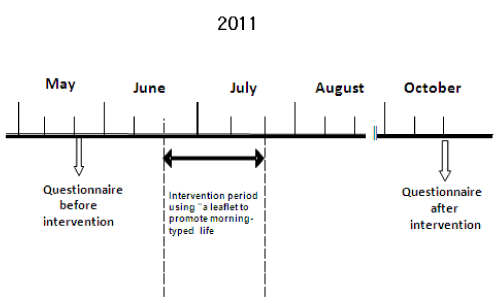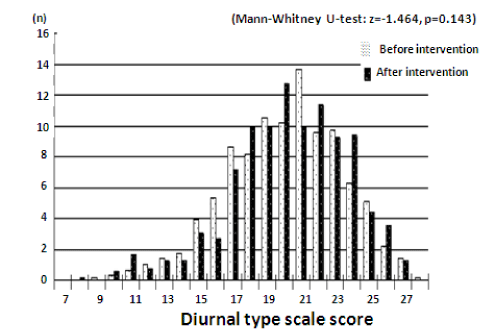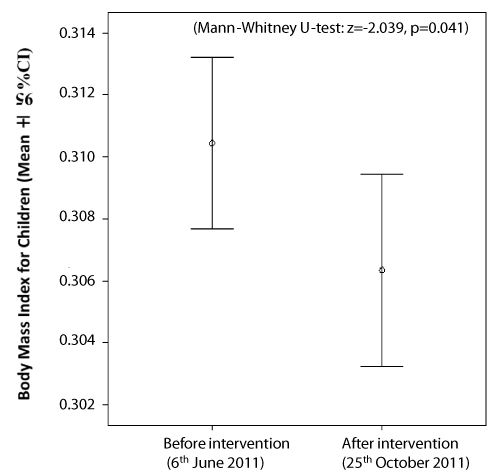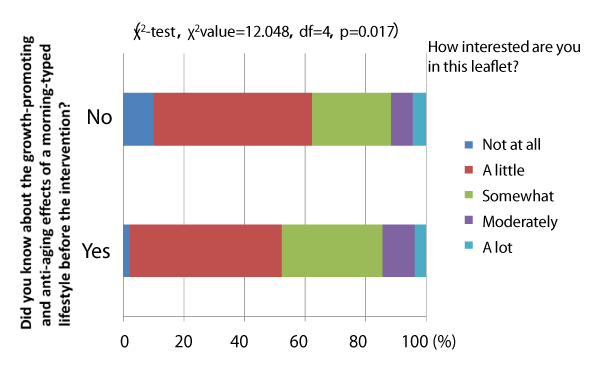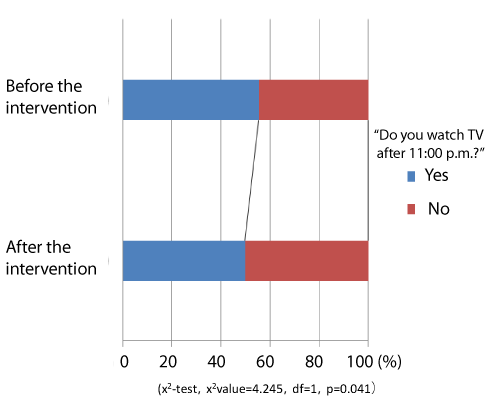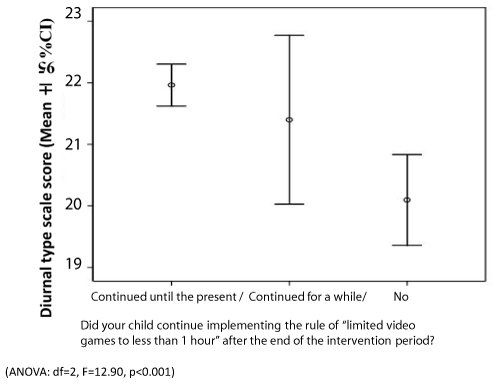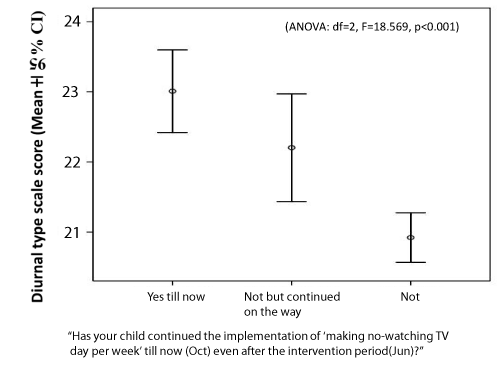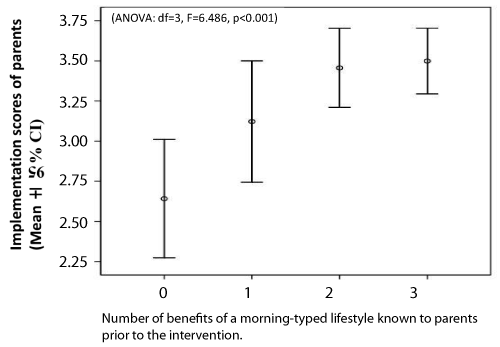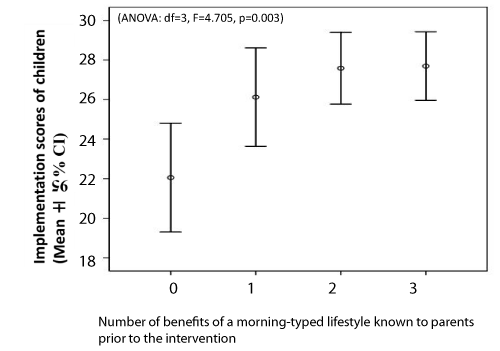
Review Article
Austin J Nutri Food Sci. 2014;2(6): 1035.
Intervention Using a Leaflet to Promote a Morning-typed Life in 2- to 6-Year-old Japanese Children and their Parents
Tetsuo Harada1*, Kiyoe Saito1, Kai Wada1, Fujiko Tsuji1,2,3, Milada Krejci2,3, Teruki Noji4, Takahiro Kawada5, Miyo Nakade6 and Hitomi Takeuchi1
1Department of Environmental Physiology, Kochi University, Japan
2Department of Health Education, University of South Bohemia, Czech Republic
3University of Physical Education and Sport, PALESTRA in Prague, Czech Republic
4Department of Physical Education, Kochi University, Japan
5Aoyama-Gakuin University, Japan
6Department of Nutritional Management, Tokai Gakuen University, Japan
*Corresponding author: :Tetsuo Harada, Department of Environmental Physiology, Faculty of Education, Kochi University, Akebonocho, Kochi 780-8520, Japan
Received: June 17, 2014; Accepted: July 10, 2014; Published: July 15, 2014
Abstract
We created a new educational material focused on three benefits of a morning-typed lifestyle and actual strategies for promoting this lifestyle. The material is a leaflet entitled, "Three benefits from going to bed early, getting up early and having breakfast. Message to mothers and fathers of young children"! In the present study, we attempted to evaluate the educational efficacy of a month-long intervention using this leaflet on 2- to 6-year-old Japanese children. About 1200 children and their parents were asked to participate in a month-long intervention from mid-June, 2011. Just before and three months after the intervention period, an anonymous integrated questionnaire was administered to participants. After the first administration of the questionnaire was done before the intervention, an envelope including a letter for parents and the leaflet was distributed through each of 10 nursery schools. The letter has the message of the purpose of the study and recommendation of following the habits shown by the leaflet for one month. Responses were received from 61% of pairs (children: 363 girls and 375 boys; parents 689 mothers and 56 fathers). Children tended to be more morning-typed after the intervention than before the intervention (p=0.07), but there was no significant difference in the Diurnal Type Scale (DTS) scores of their parents. The body mass index (BMI) of the children was significantly lower three months after the intervention period than just before the intervention (p=0.04).In the children, implementation scores were significantly correlated with their post-intervention DTS scores (p=0.001), but not with post-intervention BMI. The intervention program particularly increased morning-typed lifestyles in children through the limitation of TV and video games.
Keywords: Intervention; Leaflet; Morning-typed lifestyle; Diurnal type scale; Body mass index; young Japanese children; 2-6 years old; Video games and TV watching
Introduction
Current sleep health problems in young children
Several sleep health-related problems have been reported around the world in preschool-aged children. In a cohort study in Melbourne, Australia, sleep problems in young infants could not predict the long-term outcomes at six years of age [1]. A worldwide questionnaire study on preschool children from Asian countries (China, Hong Kong, India, Japan, Korea Malaysia, Philippines, Singapore and Thailand) and Caucasian countries (Australia, New Zealand, Canada, the United Kingdom and the United States) showed that young children from Asian countries had later bedtimes, shorter night sleep hours and a higher frequency of perceiving sleep problems than children from Caucasian countries [2]. Poorer sleep in five-year-olds in the UK was related to anxiety/depression and aggression [3].
A questionnaire study on 39,813 Japanese children aged 4.5 years old as part of a nationwide cross-sectional survey in Japan showed13.7% of children to have a total of less than 10 hours of sleep a day [4]. In that survey, a high odds ratios for shorter duration of sleep was associated with living in a less populous area, long hours spent watching TV, longer maternal working hours and attending preschool. An epidemiological study using a 1-week actigraph to measure activity in Japanese five-year-olds showed that culture-related extracurricular lessons were associated with a later bedtime in girls. On the other hand, participation in a sports group and having a fixed bathing time were related to earlier wakeup time in the morning. Sports groups were also related to higher sleep efficiency [5]. In a cross-sectional questionnaire study administered to a cohort of 1,656 kindergarten children in Jintan City, Jingsu, China, 39.4%, 31.6%, 28.0%, 24.7%, 23.4%, and 29.6% of the children had difficulty initiating sleep, nightmares, sleep talking, sleeping less, sleep resistance and fatigue, respectively [6]. Moreover, fatigue in children was associated with a lower IQ. A review of the literature from the past few years suggests that children are getting less sleep and becoming more evening-typed. Shorter sleep resulting from an evening-typed lifestyle is associated with the 24-hour commercialization of society [7,8], and may reduce the mental health of children [9-12].
Children's sleep and maternal health
A questionnaire study on 9- to 15-month-old and 48- to 55-month-old children and their mothers living in Israel suggested that the mothers' thoughts and feelings on their own childhood help form their sleep-related concerns and practices concerning their children [13]. A questionnaire study on more than 1600 mother-infant pairs (prenatal cohort study at 6months, 1year and 2 years) living in eastern Massachusetts, USA showed that maternal depression during pregnancy, early introduction of solid foods, infant TV viewing, and attendance in child care may be risk factors for shorter infant sleep duration [14].
Based on a questionnaire study on 156 primary caregiver-child pairs in the United States, bedtime resistance and daytime sleepiness in children have salient associations with parenting stress that is related to daytime behavioral problems in children with insomnia [15]. In a literature review, Lee [16] pointed out that the mothers of children with developmental disabilities (the number of which is now increasing worldwide) experienced high levels of stress as well as poor sleep and poor well-being.
The physical and mental health of young children may be very closely linked.
Relationship between sleep habits and obesity in young children
Objective data obtained with triaxial accelerometers from low-income African American eight-year-olds demonstrated that obesity in this age group is associated with characteristics of inactivity and short sleep, while children with higher reading activity were moderate-vigorous [17]. A questionnaire study and partially longitudinal follow-up were administered to 380 low-income preschool children in the Mid-west of the U.S. [18]. Longer nocturnal sleep and a smaller sleep phase difference of less than 45 minutes between weekdays and weekends were associated with a lower risk of future increases in BMI. A questionnaire study on 1,311 Chinese children aged3 to 4 years from 10 kindergarten classes in Shanghai gave on odds ratio for childhood obesity of 4.76 for children with less than 9 hours of sleep and 3.42 for those with 9.0-9.4 hours of sleep in comparison with those with more than 11 hours of sleep [19]. Short sleep duration in children was associated with short sleep duration in mothers, high education carrier of mothers and co-sleeping of children with their mothers. In one study, obese preschool-aged children in the U.S. participated in a weight management program, and pre- and post-treatment assessments of body mass, caloric intake and sleep were performed [20]. Longer post-treatment nocturnal sleep was associated with lower post-treatment BMI and lower caloric intake.
Sleep education programs for young children throughout the world
In general, sleep education is very limited worldwide, even in medical schools. To assess the prevalence of sleep education (fundamental knowledge and knowledge of sleep disorders) in medical school education, a questionnaire survey was administered to 409 medical schools in 12 countries (Australia, India, Indonesia, Japan, Malaysia, New Zealand, Singapore, South Korea, Thailand, the U.S., Canada and Vietnam) [21]. The average time spent on sleep education was just under 2.5 hours, with 27% of the schools responding with "0" hours. Australia, USA and Canada provided more than 3 hours of education on sleep. Pediatric sleep topics were covered in a mere 17 minutes compared to over 2 hours on adult sleep-related topics.
Owens et al. [22] reviewed intervention studies on recovery from sleep disorders and concluded that some treatments appear effective for some infants and children with sleep problems in families that are willing to undertake behavioral and cognitive behavioral interventions. In Malaysia, there are two common perspectives regarding sleep health education, and both result in a poor understanding of sleep among science teachers and students. A systematic sleep health education system is needed for the Muslim population in Malaysia [23]. An online, self-paced, sleep medicine learning module as an educational tool improved the overall sleep knowledge of students at Johns Hopkins Medical School compared to control students who learned a sham module [24]. In a review paper, Cassoff et al. [25] showed that school-based sleep promotion programs are not often successful because the enhanced sleep knowledge learned in the programs does not lead to sustained changes in sleep behavior. To resolve this problem, they proposed using individually tailored approaches to promote sleep health.
The effects of intervention classes (psychology classes) to promote sleep health were evaluated in eleventh grade students at three co-educational secondary schools in Adelaide, Australia [26]. Students in the intervention classes (n=51) attended four 50-minute-long sleep education classes held once a week. The classes were modified from those developed by Moseley and Gradisar [27] and included a motivational interviewing framework. The intervention group increased their knowledge on sleep compared to the control group (n=53). Students' motivation to regulate their own wake up times improved during the intervention. The intervention group also had increased motivation to lengthen the duration of their sleep time [28]. Sateia et al. [29] developed an education program that included a broad range of topics in sleep physiology and medicine and measured the effectiveness of intervention using this new program on first year medical school students in the U.S. Evaluation showed that the effectiveness of the intervention using the new program was significant. Recently, Ribeiro and Stickgold [30] discussed the potential sleep applications in the school setting and "sleep and learning" that can be taught in schools, based on the past decade of findings on rapid eye movement (REM) sleep as a key process for memory consolidation and re-construction.
Few sleep education programs have focused on circadian typology, and especially on a morning-typed lifestyle. We therefore created a new educational material focused on the three benefits of a morning-typed lifestyle and actual strategies for promoting such a lifestyle. The material is a leaflet entitled, "Three benefits from going to bed early, getting up early and having breakfast. Message to mothers and fathers of young children"! In the present study, we attempted to evaluate the educational efficacy of a month-long intervention using this leaflet on 2- to 6-year-old Japanese children.
Methods
Intervention study
A month-long intervention program starting in mid-June, 2011 was administered to about 1200 young children and their parents (Figure1) (Table 1). Before (late May 2011) and three months after (mid-October 2011) the intervention month, an anonymous integrated questionnaire was administered to the 1200 pairs. After the first administration of the questionnaire was done before the intervention, an envelope including a letter for parents and the leaflet was distributed to every parent through each of 10 nursery schools. The letter has the message of the purpose of the study and recommendation of "following the habits shown by the leaflet for one month". An envelope including the questionnaire was distributed to every parents through each of 10 nursery schools, just before and three months after the intervention month. Responses were received from 61% of the pairs (children: 363 girls and 375 boys; parents 689 mothers and 56 fathers). Parents answered the pre- and post-intervention questionnaires by themselves and on behalf of their children.
Figure 1: A schematic presentation of the intervention schedule. Participants completed anonymous questionnaires before and after the intervention.
children and their parents
Three benefits from going to bed early, getting up early and having breakfast.
Message to mothers and fathers of young children!
The three benefits:
1. Higher grades at school and evaluations at work.
2. Reduce or prevent obesity.
3. Retain your youth and aid your child's growth.
[Indeed!! But. WHY??!!]
A quick lesson in REM and non-REM sleep
During a night of sleep, we have two kinds of sleep that are completely different. Non-REM sleep can be defined as your brain's sleep, while REM sleep is your body's sleep. In non-REM sleep, the electric activity of 14 billion neurons in the cerebrum takes a break. In REM sleep, the cerebrum is dreaming. In other words, it works actively. According to a study, dreaming lets our brain fix new memories formed in the past day and consolidate whole memories into a general order. Electronic input from sensory neurons to the brain and output activities from the brain to the muscles via motor neurons stop during REM sleep. Non-REM sleep appears first, followed by REM sleep in the sleep cycle that starts about every 90 to 120minutes. Non-REM sleep in the first sleep cycle is very deep with high amplitude, low frequency brain waves, but in the last two sleep cycles, REM sleep continues quite long, for 40 to 60 minutes.
1. Three reasons why your child gets better grades at school
1.1. New memories formed at school in the past day can be fixed to the appropriate part of the brain if you have lots of REM sleep!
If you have lots of REM sleep, new memories formed at school in the past day can be fixed in the brain. (This role of REM sleep has been proven by research). As whole memories can be reconsolidated in order, correct and appropriate judgment may become possible in some work scenarios.
Fewer careless mistakes are made at school and work, because the body input and output systems take a break during REM sleep. Much of REM sleep is lost when bedtime is delayed, because most of REM appears during the last one or two sleep cycles. REM sleep readily appears at a fixed time period of4:00-7:00 a.m., and after a long sleep. This means that a morning-typed lifestyle is the only way to get enough REM sleep.
1.2. Good phase coupling of the two biological clocks creates better mental health and higher motivation to study at school and work at a job
There are two separate internal clocks in your body. If you live in a clock-less room, the two internal clocks (one is the main clock that drives your autonomic nervous system that controls systems like your core body temperature cycle, and the other clock drives your sleep-wake cycle) are synchronized. However, in 30% of people, the two clocks desynchronize to separate periods of a little more than 24 hours and 35-50 hours, respectively. This de-synchronization occurs within 1-2 months in everyone. The de-synchronization of the two clocks can destroy your mental health. We usually set (entrain) our internal clock on external time cues (several 24 hours cycles), like light, temperature or social activities at fixed times. According to our epidemiological studies over the last 15 years, morning-typed people have good entrainment, resulting in good coupling of the clocks and good mental health. However, entrainment works poorly in evening-typed people, resulting in poorer coupling of the clocks, and poorer mental health (characterized by irritation, anxiety, depression and other symptoms) than morning-typed people. A morning-typed lifestyle that includes going to bed early, getting up early and having breakfast is good for mental health and should be prepared before daily study at school.
1.3. Concentration on studying and work activities improves because of increased synthesis and secretion of serotonin in the brain.
Investigations on children in Kochi city and students at F.C-Kochi University have shown that exposure to sunlight after eating natto (fermented soybeans) and bananas at breakfast allows tryptophan contained in the natto to metabolize to serotonin in the brain with the help of sun exposure and vitamin B6 contained in the bananas. The higher concentration of serotonin in the brain improves concentration during study and work. The serotonin turns into melatonin at night that helps induce sleep at night. The melatonin orders our brain to go to bed early.
2. Why obesity can be reduced or prevented by a morning-typed lifestyle
Our recent studies have shown that a 1 to 2 hour phase advance in the sleep-wake cycle increases the amplitude of activity rhythms and the total daily amount of activity by 1.5 times. The resulting increase in metabolism helps prevent obesity.
3. Why a morning-typed lifestyle is good for the growth of children and cosmetic issues in mothers.
The reason is growth hormone. This hormone promotes growth in children and restores body parts such as skin and small vessels in adults that were damaged during the day. The timing of synthesis of growth hormone and its secretion to the circulating system is fixed to 8:00-9:00 p.m. in children and 11:00 p.m. in adults via the circadian clock. The slow brain wave stage in non-REM sleep is needed for full secretion of growth hormones. A late bed-time therefore reduces the amount of growth hormone secreted in children and their mothers. Sufficient growth of children is inhibited and wrinkles and spots on skin may increase in mothers.
The recommended bedtime for young children is 7:00-8:00 p.m. and for mothers is 10:30 p.m.!
Habits recommended in daily life to change your diurnal rhythms to morning-type!
1. LIGHT has a stronger influence than medicine.
Step1. Let's expose ourselves to sunlight or a fluorescent (or blue or white LED) light just after waking early in the morning!
In the summer, the sun rises early, so hang THIN curtains. In the winter, the sun rises later, so turn on ALL OF THE FLUORESCENT LIGHTS in your home.
REASON (backed by evidence): This helps advance the phase of the internal clock. The clock phase has a period of slightly longer than 24 hours and easily becomes delayed in comparison with the environmental 24-hour cycle.
Step2. Let's expose ourselves to sunlight after breakfast!
REASON (backed by evidence) Doing so gives you a large amount of serotonin, a neuroamine that promotes concentration during learning and work that is synthesized and secreted in the brain. The serotonin peak may become an inner cue that can maintain a fixed circadian clock phase that is not delayed.
Step3. Let's use INCANDESCENT LIGHTS after sunset.
REASON (backed by evidence): Melatonin, the sleep induction hormone, enters the blood at night to help you get to sleep soon. Blue light that is contained in fluorescent lights stops the melatonin discharge.
1. Recommendation for lighting
1. Daytime lighting: Lighting similar to the SUN: a fluorescent light or blue or white LED light.
2. Nighttime lighting: Lighting similar to the MOON: an incandescent light, a fireplace, a candle or a sunken hearth.
2. Breakfast CONTENT is important!
Have some PROTEIN SOURCES in your breakfast! Especially NATTO (fermented soybeans) is the best recommendation. It's an amazing food, because the coefficient of digestibility is 98%. That means that even when you have only a little bit of natto, the tryptophan it contains that is a precursor for serotonin is absorbed. Boiled eggs are a good alternative for children who don't like natto. Try preparing it the night before. Of course ham, bacon, dried fish and cooked fish are also effective. Add one more dish to your usual breakfast as a source of protein, because protein-rich foods also have vitaminB6 that promotes serotonin synthesis. It is excellent to also have some vegetables and fruits!!
3. Let's limit TV and video games at night to one hour! Please set a NO-TV day and a NO-VIDEO-GAME day every week.
The proportion of elementary and junior high school students who have game consoles is increasing in Japan. For kindergarten children and first and second grade students in elementary school, playing video games after sunset for more than one hour or everyday is bad for sleep and mental health (based on scientific evidence). Let's make a NO-VIDEO-GAME day!
Melatonin is suppressed by watching TV at night, which can delay the phase of the circadian clock in children (based on scientific evidence).
Reduce TV time in the evening and at night!! Let's make a NO-TV-DAY!
Column
An evening-typed lifestyle is the greatest enemy for women trying to maintain their health!Have pleasant days with a morning-typed life style!!
- The relationship between the shift to evening-type in female junior high school students and heavy use of mobile phones
Results of research by a research team under Prof. Harada showed that female junior high school students in Japan are shifting to evening-type, and that one of the reasons is heavy use of mobile phones at night.
When girls become evening-typed, their menstrual cycle, a fundamental physiological system for reproduction, becomes irregular, with irregular menstruation timing, severe menstrual pain and severe symptoms of premenstrual syndrome (PMS: mental and physical symptoms such as headaches and irritation). Junior high school is the critical period for girls for constructing their reproductive system including their menstrual cycle. If girls cannot maintain a morning-typed lifestyle, this physiological construction becomes damaged and they cannot achieve a strong and healthy menstrual cycle. Junior high school students who have received sleep guidance tend to be morning-typed.
Please give your child sleep guidance as a preparation for the future.
These facts apply completely to junior high school students.
- Women can gain particularly great benefits from a morning-type lifestyle.
A morning-type lifestyle makes the menstrual cycle able and strong with regular cycles. This means that within can gain great benefits from a morning-type lifestyle.
Table 1: English version of the entire leaflet that was used for the month-long intervention in young Japanese.
An integrated questionnaire
The Diurnal type scale
A version for children [9] of the Diurnal Type Scale (DTS) [31] was used to measure diurnal preference. The DST consisted of seven questions: three pertaining to sleep onset, three to sleep offset, and one to peak time of activity. Each question allows choice from four answers. The score of DTS was the sum of the seven answers. Scores ranged from 7 to 28, with lower scores indicating evening-type and higher scores indicating morning-type.
Body mass index
Body mass index (BMI: kg/m2) was compensated for young age using a numerical formula developed by the World Health Organization (WHO) [32].
- Implementation Score
- In your response to the question, "How do you shift to 'Go to bed, early! Get up early! and Do not forget breakfast!'?" in the leaflet, how many days did your child follow implementation 1-A: "Let's expose ourselves to sunlight just after wakening early in the morning" during the 30-day-long intervention period?
- 0-5, (2) 6-10, (3) 11-15, (4) 16-20, (5) 21-25, (6) 26-30
- In your response to the question, "How do you shift to 'Go to bed, early! Get up early! and Do not forget breakfast!'?" in the leaflet, how many days did your child follow implementation 1-B: "Let's expose ourselves to sunlight after breakfast!" during the 30-day-long intervention period?
- 0-5, (2) 6-10, (3) 11-15, (4) 16-20, (5) 21-25, (6) 26-30
- In your response to the question, "How do you shift to 'Go to bed, early! Get up early! and Do not forget breakfast!'?" in the leaflet, how many days did your child follow implementation 1-C: "Let's use INCANDESCENT LIGHTS after sunset." during the 30-day-long intervention period?
- 0-5, (2) 6-10, (3) 11-15, (4) 16-20, (5) 21-25, (6) 26-30
- In your response to the question, "How do you shift to 'Go to bed, early! Get up early! and Do not forget breakfast!'?" in the leaflet, how many days did your child follow implementation 2: "Have some PROTEIN SOURCES in your breakfast!" during the 30-day-long intervention period?
- 0-5, (2) 6-10, (3) 11-15, (4) 16-20, (5) 21-25, (6) 26-30
- In your response to the question, "How do you shift to 'Go to bed, early! Get up early! and Do not forget breakfast!'?" in the leaflet, how many days did your child follow implementation 3: "Let's limit TV and video games at night to one hour! Please set a "NO-TV and NO-VIDEO-GAME day" every week." during the 30-day-long intervention period?
- 0-5, (2) 6-10, (3) 11-15, (4) 16-20, (5) 21-25, (6) 26-30
- Ethical treatment
- Statistical Analysis
- Price AM, Wake M, Ukoumunne OC, Hiscock H. Outcomes at six years of age for children with infant sleep problems: longitudinal community-based study. Sleep Med. 2012; 13: 991-998.
- Mindell JA, Sadeh A, Kwon R, Goh DY. Cross-cultural differences in the sleep of preschool children. Sleep Med. 2013; 14: 1283-1289.
- Sheridan A, Murray L, Cooper PJ, Evangeli M, Byram V, Halligan SL. A longitudinal study of child sleep in high and low risk families: Relationship to early maternal settling strategies and child psychological functioning. Sleep Medicine. 2013; 14: 266-273.
- Ikeda M, Kaneita Y, Kondo S, Itani O, Ohida T. Epidemiological study of sleep habits among four-and-a-half-year-old children in Japan. Sleep Med. 2012; 13: 787-794.
- Iwata S, Iwata O, Iemura A, Iwasaki M, Matsuishi T. Determinants of sleep patterns in healthy Japanese 5-year-old children. Int J Dev Neurosci. 2011; 29: 57-62.
- Liu J, Zhou G, Wang Y, Ai Y, Pinto-Martin J, Liu X. Sleep problems, fatigue, and cognitive performance in Chinese kindergarten children. J Pediatr. 2012; 161: 520-525.
- Harada T, Nakade M, Wada K, Kondo A, Maeda M, Noji T, et al. Mental health of children from a chronobiological and epidemiological point of view. In: Essential Notes in Psychiatr. 2012; 439-458.
- Harada T, Nakade N, Wada K, Akimitsu O, Noji T, Krejci M, et al. Tryptophan and sleep: breakfast tryptophan content and sleep. In: Handbook of Nutrition, Diet and Sleep. 2013; 3: 473-487.
- Harada T, Hirotani M, Maeda M, Nomura H, Takeuchi H. Correlation between breakfast tryptophan content and morningness-eveningness in Japanese infants and students aged 0-15 yrs. Journal of Physiological Anthropology. 2007; 26: 201-207.
- Nakade M, Takeuchi H, Taniwaki N, Noji T, Harada T. An integrated effect of protein intake at breakfast and morning exposure to sunlight on the circadian typology in Japanese infants aged 2-6 years. Journal of Physiological Anthropology. 2009; 28: 239-245.
- Nakade M, Akimitsu O, Wada K, Krejci M, Noji T, Taniwaki N, et al. Can breakfast Tryptophan and Vitamin B6 intake and morning exposure to sunlight promote morning-typology in young children aged 2-6 years? Journal of Physiological Anthropology. 2012; 31: 11.
- Akimitsu O, Wada W, Noji T, Taniwaki N, Krejci M, Nakade M, et al. The relationship between consumption of tyrosine and phenylalanine as precursors of catecholamine at breakfast and the circadian typology and mental health in Japanese infants aged 2 to 5 years. Journal of Physiological Anthropology. 2013; 32: 13.
- Aviezera O, Scherc A. Children's sleep regulation is linked to mothers' sleep-related childhood experiences. Early Childhood Research Quarterly. 2013; 28: 271- 281.
- Nevarez MD, Rifas-Shiman SL, Kleinman KP, Gillman MW, Taveras EM. Associations of early life risk factors with infant sleep duration. Acad Pediatr. 2010; 10: 187-193.
- Byars KC, Yeomans-Maldonado G, Noll JG. Parental functioning and pediatric sleep disturbance: An examination of factors associated with parenting stress in children clinically referred for evaluation of insomnia. Sleep Medicine. 2011; 12: 898-905.
- Lee J. Maternal stress, well-being, and impaired sleep in mothers of children with developmental disabilities: a literature review. Res Dev Disabil. 2013; 34: 4255-4273.
- Harrington SA. Relationships of objectively measured physical activity and sleep with BMI and academic outcomes in 8-year-old children. Appl Nurs Res. 2013; 26: 63-70.
- Miller AL, Kaciroti N, Lebourgeois MK, Chen YP, Sturza J, Lumeng JC. Sleep timing moderates the concurrent sleep duration-body mass index association in low-income preschool-age children. Acad Pediatr. 2014; 14: 207-213.
- Jiang F, Zhu S, Yan C, Jin X, Bandla H, Shen X. Sleep and obesity in preschool children. J Pediatr. 2009; 154: 814-818.
- Clifford LM, Beebe DW, Simon SL, Kuhl ES, Filigno SS, Rausch JR, et al. The association between sleep duration and weight in treatment-seeking preschoolers with obesity. Sleep Med. 2012; 13: 1102-1105.
- Mindell JA, Bartle A, Wahab NA, Ahn Y, Ramamurthy MB, Huong HT, et al. Sleep education in medical school curriculum: a glimpse across countries. Sleep Med. 2011; 12: 928-931.
- Owens LJ, France KG, Wiggs L. Review article: Behavioural and cognitive-behavioural interventions for sleep disorders in infants and children: A review. Sleep Med Rev. 1999; 3: 281-302.
- Tumiran MA, Saat RM, Rahman NNA, Adli DSH. Sleep from neuroscience and Islamic perspectives: comprehension and practices of Muslims with science background in Malaysian education system. Procedia Social and Behavioral Sciences. 2010; 9: 560-564.
- Salas RE, Gamaldo A, Collop NA, Gulyani S, Hsu M, David PM, et al. A step out of the dark: improving the sleep medicine knowledge of trainees. Sleep Med. 2013; 14: 105-108.
- Cassoff J, Knäuper B, Michaelsen S, Gruber R. School-based sleep promotion programs: effectiveness, feasibility and insights for future research. Sleep Med Rev. 2013; 17: 207-214.
- Cain N, Gradisar M, Moseley L. A motivational school-based intervention for adolescent sleep problems. Sleep Med. 2011; 12: 246-251.
- Moseley L, Gradisar M. Evaluation of a school-based intervention for adolescent sleep problems. Sleep. 2009; 32: 334-341.
- Cain N, Gradisar M, Moseley L. A motivational school-based intervention for adolescent sleep problems. Sleep Med. 2011; 12: 246-251.
- Sateia MJ, Reed VA, Christian Jernstedt G. The Dartmouth sleep knowledge and attitude survey: development and validation. Sleep Med. 2005; 6: 47-54.
- Ribeiro S, Stickgold R. Sleep and school education. Trends in Neuroscience and Education. 2014; 3: 18-23.
- Torsvall L, Akerstedt T. A diurnal type scale. Construction, consistency and validation in shift work. Scand J Work Environ Health. 1980; 6: 283-290.
- World Health Organization (WHO) BMI-for-age (5-19 years).
- Portaluppi F, Smolensky MH, Touitou Y. Ethics and methods for biological rhythm research on animals and human beings. Chronobiol Int. 2010; 27: 1911-1929.
- Murray G, Allen NB, Trinder J. Seasonality and circadian phase delay: prospective evidence that winter lowering of mood is associated with a shift towards Eveningness. J Affect Disord. 2003; 76: 15-22.
- Harada T, Hiraoka M, Kawasaki K, Uesato T, Wada K, Nakade M, et al. Are obese mothers of children aged 1-6 years evening-typed? International Journal of Psychological Studies. 2014; in press.
- Andrews JL, Zhang X, Mc Carthy JJ, Mc Dearmon EL, Hornberger TA, Russell B, et al. (2010). CLOCK and BMAL1 regulate MyoD and are necessary for maintenance of skeletal muscle phenotype and function. Proceedings of the National Academy of Sciences of the United States of America. 2010; 107: 19090-19095.
- Garaulet M, Gómez-Abellán P2. Timing of food intake and obesity: A novel association. Physiol Behav. 2014.
- Blunden SL, Chapman J, Rigney GA. Are sleep education programs successful? The case for improved and consistent research efforts. Sleep Med Rev. 2012; 16: 355-370.
- Honma K, Honma SA. Human phase-response curve for bright light pulses. Japanese Journal of Psychiatry Neurology. 1988; 42: 167-168.
- Obal F Jr, Krueger JM. GHRH and sleep. Sleep Med Rev. 2004; 8: 367-377.
- Kutner M, Greenberg E, Jin Y, Paulsen C. The health literacy of America's adults: Results from the 2003 National Assessment of Adult Literacy (NCES 2006-483). Washington, DC: U.S. Department of Education, National Center for Education Statistics. 2006.
During the month-long intervention, participants were asked to follow five rules in the leaflet (Table 2). They were given five questions with six possible responses each, and the sum of the scores from those five questions was the implementation score, ranging from 6 to 30 points.
Table 2: Details of the month-long intervention from mid-June 2011.
The study protocol complied with the guidelines of the journal Chronobiology International for research on human participants [33]. Before starting the study, each of the parents was given a written explanation that detailed the concepts and purposes of the study and stated that their answers would be used only for academic purposes. After the above explanation, all parents agreed completely with the proposal. The study was also permitted by the nurses' committees of the ten nursery schools and one kindergarten that conducted an ethical inspection of the content of the leaflet and the integrated questionnaire.
Pre- and post-intervention questionnaire answers were statistically analyzed with χ2-tests, Mann-Whitney U-tests, Kruskal- Wallis tests and one-way analysis of variance (ANOVA) with SPSS 12.0 statistical software. DTS scores were expressed as means and standard deviations (Mean ± SD).
Results
DTS scores and BMI before and after the intervention
Children tended to be more morning-typed after the intervention in October 2011 than before the intervention in June (z=-1.77, p=0.07) (Figure 2), but there was no significant difference in the DTS scores of their parents (z=-1.464, p=0.143) (Figure 3). Children's BMIs were significantly lower three months after the intervention period than just before the intervention (Mann-Whitney U-test, z=-2.04, p=0.04) (Figure 4).
Figure 2: Distribution of diurnal type scale scores of 2- to 6-year-old Japanese children before and after the month-long intervention.
Figure 3: Distribution of diurnal type scale scores in parents before and after the intervention.
Figure 4: Body mass indexes of 2- to 6-year-old Japanese children before and after the intervention.
Intervention and parents' habits and interest
Implementation scores and DTS scores were positively correlated in parents (Kruskal-Wallis test, χ2-value=14.567, df=3, p=0.002) (Figure 5). The ratio of parents who already knew the benefits of a morning-typed lifestyle before the intervention were 68% for "higher grades in academic courses in school", 43% for "reduction of obesity", and 77% for "promotion of growth and anti-aging effects". Parents who already knew the third benefit were more interested in the leaflet than those who did not (χ2-test, χ2value=12.048, df=4, p=0.017) (Figure 6). The ratio of parents who watched late-night TV after 11:00 p.m. was higher before the intervention period than after the intervention period (χ2-test, χ2value=4.245, df=1, p=0.041(Figure 7).
Figure 5: Relationship between the implementation scores for the leaflet promoting a morning-typed lifestyle and the diurnal type scores of the children.
Figure 6: Relationship between prior knowledge of the leaflet information on the growth-promoting and anti-aging effects of a morning-typed lifestyle andthe extent of interest in the leaflet as a whole.
Figure 7: The ratio of parents who watched late-night TV after 11:00 p.m. before and after the intervention.
Implementation and circadian typology and BMI of young children
Children who continued implementing the rule of 'limited video games to less than 1 hour' for three months after the intervention period had significantly higher DTS scores than those who did not (one-way ANOVA: df=2, F=12.90, p<0.001) (Figure 8). Those who continued implementing the rule of 'limited TV to less than 1 hour' (one-way ANOVA: df=2, F=17.678, p<0.001) (Figure 9), 'one no-video-game day per week' (df=2, F=7.737, p<0.001) (Figure 10) and 'one no-TV day per week' (df=2, F=18.569, p<0.001)(Figure 11)for three months after the intervention period had higher DTS scores than those who did not.
Figure 8: Relationship between children continuing the rule of "limited video games to less than 1 hour" after the intervention and their diurnal type scale scores.
Figure 9: Relationship between children continuing the rule of "limited TV to less than 1 hour" after the intervention and their diurnal type scale scores. hour" after the intervention and their diurnal type scale scores.
Figure 10: Relationship between children continuing the rule of "making one NO-VIDEO-GAME day per week" after the intervention and their diurnal type scale scores.
Figure 11: Relationship between children continuing the rule of "making one NO-TV day per week" after the intervention and their diurnal type scale scores.
Figure 12: Relationship between implementation scores of parents and their prior knowledge of the three benefits of a morning-typed lifestyle before the intervention.
Figure 13: Relationship between implementation scores of the children and their parents' prior knowledge of the three benefits of a morning-typed lifestyle before the intervention.
In the children, implementation scores were significantly correlated with their post-intervention DTS scores (Pearson's correlation test, r=0.267, p=0.001), but not with post-intervention BMI (r=0.094, p=0.254).
Implementation and knowledge of the three benefits of a morning-typed lifestyle
The number of benefits of a morning-typed lifestyle that were known by parents before the intervention was positively correlated with the implementation scores of both the parents (one-way ANOVA: df=3, F=6.486, p<0.001) and the children (ANOVA: df=3, F=4.705, p=0.003) (Figures 12,13).
Conclusion
Promoting a morning-typed lifestyle and reducing BMI in young children with a leaflet intervention
Both the children and their parents were more morning-typed after the intervention than before the intervention, even though there is a shorter photoperiod in October when the post-intervention questionnaire was administered, meaning that the sun rises later and there is less sunlight early in the morning. The lack of morning light can force a delay in the circadian phase [34]. The change to morning-type therefore appears to be due to the intervention, not to seasonal variation.
Circadian typology and obesity in young children
Several studies have shown that longer sleep is associated with a lower risk of obesity (for example, Jiang et al. [19] and Clifford et al. [20]). However, few studies have examined the relationship between circadian typology and obesity. Harada et al. [35] recently reported that obese mothers of 2- to 6-year-olds were significantly more evening-typed than other mothers. Moreover, a positive correlation was seen between the BMI of the children and that of their mothers. In this report, BMI decreased after the intervention in comparison with pre-intervention BMI.
What is the mechanism of evening-type-driven obesity? An evening-typed lifestyle accompanied by a shorter duration of sleep at night may induce obesity in young children. As a hypothetical mechanism, a delayed circadian phase may reduce their activity level and reduce calorie expenditure. A mutant mouse created by reduction of BMAL1 gene expression that encodes proteins regulating circadian rhythms was reported to show about a 30% reduction in muscle force and 40% reduction in mitochondrial volume [36]. The human circadian phase may also be related to BMAL1 expression and consequently linked to mitochondrial volume and muscle force. Further studies are needed to examine such a relationship. Another possible mechanism is that calories consumed later in the circadian phase by evening-typed children may be used to increase the amount of fatty tissue under the skin and around the guts, liver, heart and other organs [37].
Efficacy of sleep education focusing on circadian typology
There have been many case studies on sleep education programs and their educational efficacy throughout the world (for example, Blunden et al. [38]). However, few studies have been conducted on the efficacy of sleep education with a focus on circadian typology. In Japan, an extremely evening-typed society, partially due to 24-hour commercialization, sleep education including the recommendation of a morning-typed lifestyle is very important. The reason for this is that an extremely evening-typed lifestyle has a higher risk of promoting poor mental health due to lower serotonin synthesis in daytime, lost coupling of the two biological clocks (two clocks hypothesis of main and slave clocks [39]), and less consolidation of negative memories due to the loss of REM sleep. A late bedtime accompanied with an evening-typed lifestyle can depress the growth hormone level at night, as sufficient secretion of this hormone must occur during the slow wave phase of non-REM sleep [40].
Higher academic knowledge of parents may be positively related to their interest in the leaflet. Higher interest based on a higher level of education may lead to the active implementation of the recommendations in the leaflet. The implementation of limited TV and video games in their children may promote their morning-typology.
The ratio of parents who already knew the benefits of a morning-typed lifestyle for the intervention were high for the mothers of a kindergarten who got higher grades of education in university. This observation would be important because the reading level for the leaflet would be high (many multi-syllable words etc.). In the United States, "Nearly 9 out of 10 adults have difficulty using the everyday health information that is routinely available in our healthcare facilities, retail outlets, media and communities [41]. Special issue of the leaflet for the mothers who got only compulsory schools may be needed for them and should be prepared in the near future.
Limitations of this study
The intervention period was relatively short in this study. A longer intervention period of three or six months may be more effective for promoting a morning-typed lifestyle in children. Moreover, direct interventions, for example having natto or cow's milk, using a lighting apparatus that emits low color temperature light (incandescent lamps as opposed to fluorescent lamps or LEDs that emit blue light), may be particularly useful for determining the efficacy of the leaflet.
The positive change in BMI might be associated with the food eaten (was at breakfast and/or the addition of breakfast into the child's morning routine. The analysis of these factors would be remained for the future study. Also this study was concerning 2-6 year old Japanese children and the leaflet contained information concerning "The relationship between the shift to evening-type in female junior high school students and heavy use of mobile phones", this information does not seem pertinent to the 2-6 year old child, although mothers can understand this information for the future education for their own daughters.
Finally, this study was based on anonymous questionnaires. Partially-anonymous questionnaires (random numbering by the kindergarten and nursery school staff and no information given to the analyzing researcher on the identification of individuals) could be a powerful method for one-by-one, precise analysis of the efficacy of the intervention.
Acknowledgement
Sincere thanks are due to all the participants who were attendants at nursery schools founded by Kochi city or the kindergarten affiliated to the Faculty of Education, Kochi University, and their parents who agreed to take part in the study. We would like to thank the JSPS Support Foundation for Promotion of Sciences (No. 22370089, 2010- 2013, to T Harada) and the Research Foundation of the Japan Dairy Association (J-MILK) (2013-2015) (to T. Harada). Thanks are also due to Miss Laura Sato for her great language editorial support to make this MS.
References
